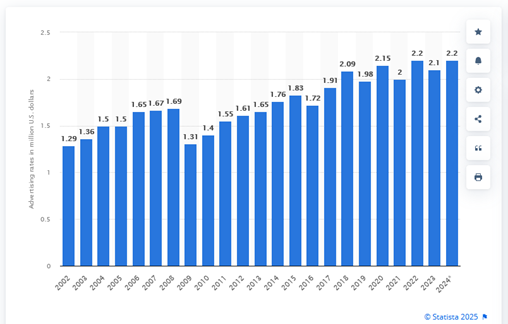In Hollywood, Oscar night is known as the “Super Bowl for women”. It's no wonder that brands are racing to reach out to ladies who are delighted by the sight of their favourite actors. Some looked down on them from the poster-plastered walls in the ladies’ younger days and are now just a nostalgic memory, while others have nestled in their imagination and fantasies for good.
Big event, high prices
The Academy Awards are simply a unique opportunity, and advertising prices correspond to this. The sums are exorbitant and growing. According to statista.com, the average cost of a 30-second spot aired during the Oscars in 2024 was $2.2 million. That represented an increase from the previous year, when the value was $2.1 million.

Luxury brands scored points at the Oscars in 2024
The spectacular show is an annual parade of glittering gowns, glamour style and luxury. So, it’s no surprise that, in addition to ads for new films and shows, last year’s scores were driven by luxury brands, led by iconic watch brand Rolex, which came up with a spot highlighting the brand’s position in popular film and TV:
Video: 2024 Rolex Oscars ad
The product placement of Don Julio tequila, for example, was also a success, crowned by higher sales. Comedian Guillermo Rodriguez used this tequila to toast attendees at the Oscars as part of a sponsored moment during the broadcast:
Video: Don Julio - product placement during the Oscars
Oscar-winning TV ad
However, the Oscars theme can be used outside of the awards ceremony as well. Many ads mimic the style of film trailers or Oscar-winning films, or use a film-style narrative or take inspiration from an Academy Award-winning film to communicate the advertising message. They also often feature well-known Oscar-winning actors such as Matthew McConaughey or Charlize Theron, or Oscar-winning directors such as Ridley Scott. Indeed, the glare of an Oscar, whether won by a director, actor or film, transfers an aura of success to products and brands and can increase demand for the associated brands and products.
Oscar-winning actors include Anthony Hopkins, who has been nominated for the award six times and has actually won it twice - for Best Performance in a Leading Role in the film The Father and Best Performance in a Leading Role in the film The Silence of the Lambs. While he didn’t win an Oscar for his STōK Cold Brew coffee ad, he did help the brand make a name for itself among other advertisers at Super Bowl 2024.
Video: STōK Cold Brew - Anthony Hopkins
Robert De Niro was nominated nine times, turning two of those nominations into Oscars. In the advertising business, he is in his element. He has been in Thanksgiving, insurance, Kia and American Express ads. His most memorable stunts include the “No Drama” ad with tennis player Roger Federer. In the humorous spot, Federer is persuaded by Switzerland Tourism, the Swiss official national tourism office, to take part in his film project in Switzerland. De Niro refuses to act in the film because in Switzerland, there is “no drama”…
Video: Switzerland Tourism - De Niro
The legendary American director Martin Scorsese did not disdain advertising either. In the “One Hour Photo” ad, he portrayed himself as he received photographs from his nephew’s birthday party in a one-hour photo lab and analysed them with typical directorial care. The ad for American Express gained attention because of Scorsese’s brilliant self-irony. The famous Oscar-winning director has starred in a number of his films, so it’s no surprise that he handled his role in the ad with virtuosity:
Video: American Express - Martin Scorsese
Oscar-winning films also enjoy a great deal of interest from brands. A huge range of creatives are inspired by award-winning films. The Oscar - as a symbol of filmmaking excellence - adds a stamp of exclusivity to advertising. The positive perception of the film is then transferred to the brand. Oscar-winning films tend to be emotionally powerful and memorable. Viewers associate the brand with a story that resonates with them, which increases its memorability. Oscar-winning films are often discussed and receive wide media coverage, allowing the brand to connect to current cultural events. Advertising inspired by an award-winning film thus benefits from the film’s popularity and media coverage. So, it's no wonder that some Oscar-winning films are used by creatives, agencies and brands with incredible frequency. A typical case in point is the 1995 film Forrest Gump, which inspired the Postal Service, a coffee retailer, and also a car dealer, LG Electronics, and a grocery chain whose mascot, Frank, performs a Forrest Gump-like moonwalk, plays ping-pong, runs and even sits on a bench where he opens his suitcase instead of a box of chocolates...
Video: Fareway - Forrest Gump
Television and film belong together - not only during the awards ceremony
Television and the film industry work in symbiosis with each other. The Oscars attract a huge amount of attention, while advertising helps to fund broadcasts and promote films that may win an Oscar.
But the link between television and the film industry is far from being limited to the spectacular award show.
Television is a medium with a wide reach and is the preferred choice of viewers when watching films and long-form videos - despite the boom of mobile devices and other platforms. The living room in the home continues to be a place where family members can experience emotions together, discuss the plot, and become fully immersed in the story. Watching together is a kind of film night ritual that not only allows for deeper immersion in the content but also means more time spent in front of the screen.
This way of watching has, of course, a significant positive impact on the perception of the advertisements that are part of the television broadcast. Viewers watching content on a big screen are less distracted by their surroundings than when consuming content on a mobile or laptop, where they switch between apps more easily. And this makes it more likely that viewers will not only notice the ad but also remember it better.
In addition, shared viewing, whether with family or friends, reinforces the social confirmation effect - if an ad captures a viewer’s attention, it can spark a discussion or a shared response that enhances recall.
Thanks to these factors, linear television still maintains its role as one of the most effective media. This effect is particularly crucial at major events such as the Oscars, where viewers expect not only a top-notch film presentation but also premium advertising spots that match the atmosphere of the evening. Advertisers are aware that this is an event that allows them to reach the audience in maximum concentration and are happy to take advantage of this chance.

